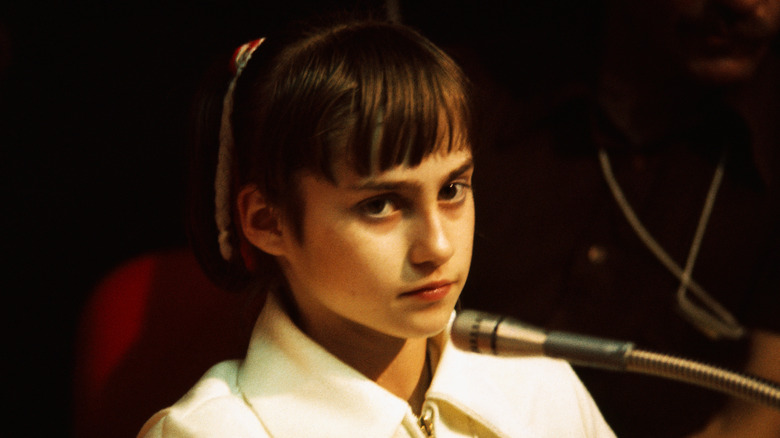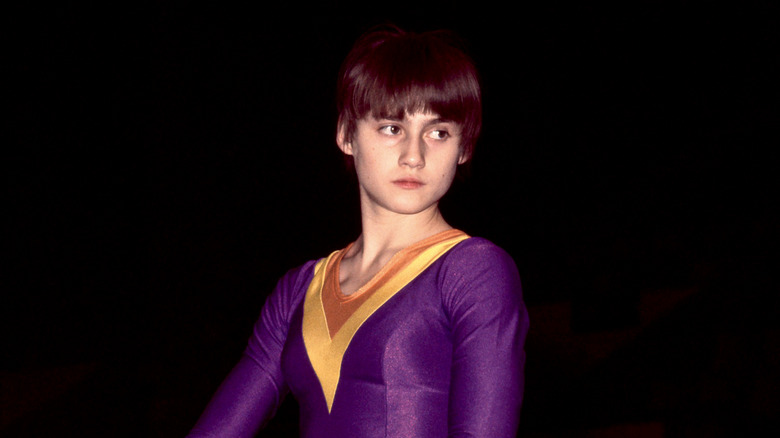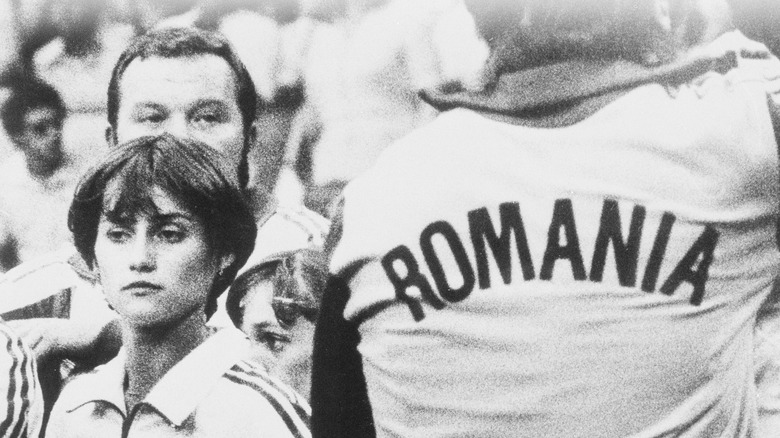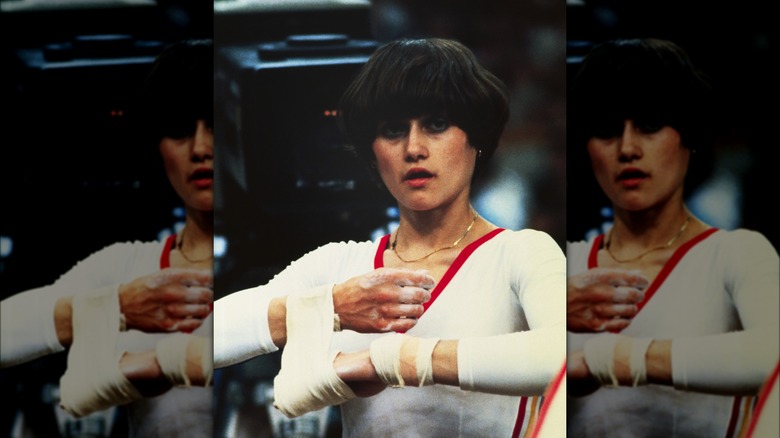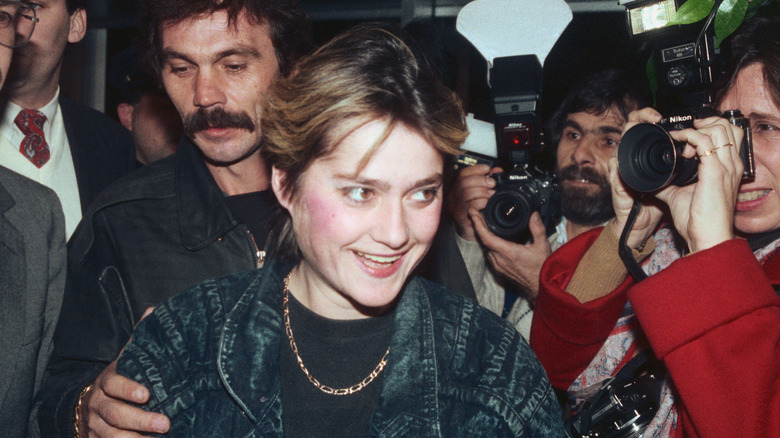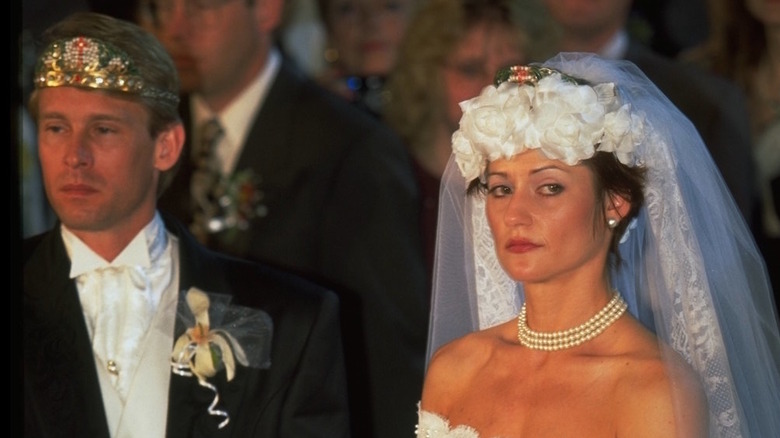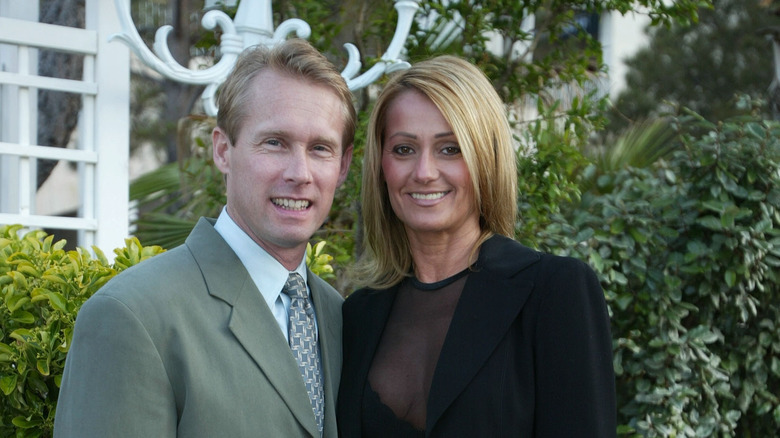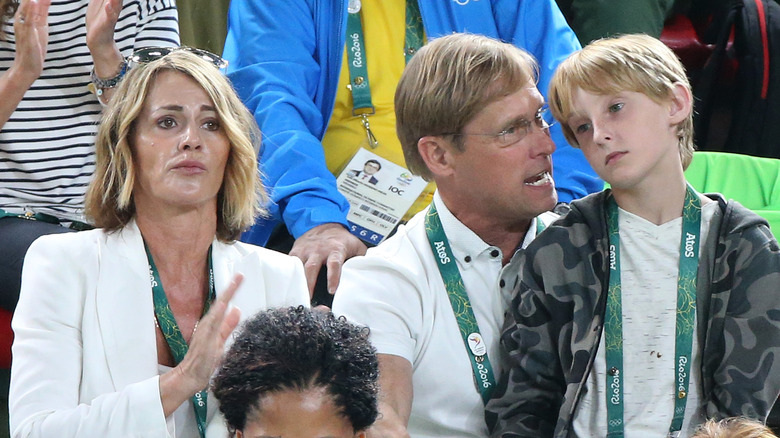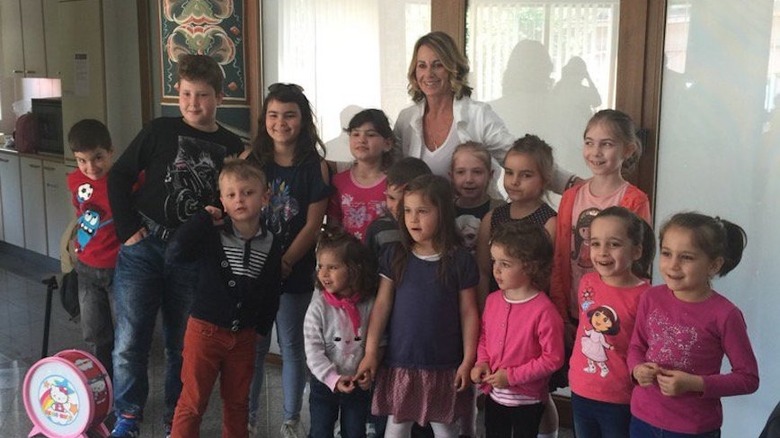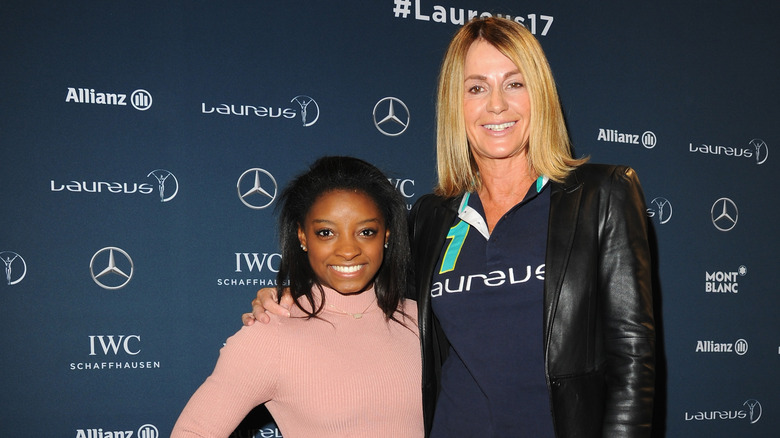What Happened To Olympic Gymnast Nadia Comăneci?
Romanian gymnast Nadia Comăneci became a worldwide sensation when, at just 14 years old, she became the first gymnast in history to receive a perfect score at the 1976 Olympic games in Montreal. Suddenly, she became a famous figure, particularly in the United States, captivating television viewers and stirring millions to become fans of the sport, an athletic pursuit they might otherwise have ignored. She walked away from the Montreal games with three gold medals, one silver, and one bronze. So popular was Comăneci that the music that accompanied her perfect performance — then titled "Cotton's Theme," best known as the theme song for daytime soap opera "The Young and the Restless" — became so associated with her that it was retitled "Nadia's Theme," and released as a single shortly after.
For the next few years, Comăneci continued to be a force to be reckoned with, and she wasn't exactly what one would describe as modest about her accomplishments. "If it was perfect, then I deserved it," she once told Sports Illustrated of her perfect score. However, gymnasts' careers are not typically long ones, and eventually she exited the sport that had made her an icon.
In the decades that have passed since then, life has taken her on numerous twists and turns.
She was a Romanian hero but her own government spied on her
After her perfect score in 1976, Nadia Comăneci was honored by her country when she was awarded the Gold Medal of Hero of Socialist Labour by Romanian president Nicolai Ceaucescu. While she was celebrated by her fellow citizens, her newfound fame placed her under intense scrutiny with the country's communist government. This included restrictions being imposed on her travel.
Restricted travel wasn't the only fallout. Romanian historian Stejarel Olaru discovered the shocking truth in government documents he obtained for his 2021 book, "Nadia and the Securitate," detailing the government's treatment of the young athlete after the Montreal Olympics.
As Olaru told Balkan Insights, Comăneci and her family were all placed under constant surveillance, with their phones tapped and hidden microphones installed in the family's home. In addition, there was also a small army of informants tracking her every move and reporting back to Romania's secret police. Olaru told Radio Free Europe/Radio Liberty, "There were dozens, maybe hundreds of people spying on the gymnasts and coaches ... a complex network."
Her life in Romania became fraught after her trainer's defection
As tightly controlled as it already was, Nadia Comăneci's life in Romania grew even more complicated in 1981 when her longtime coach, Béla Károlyi, defected to the United States. With Romanian leader Nicolae Ceausescu fearful that Comăneci would follow suit, the restrictions that had already been imposed upon her tightened considerably. In the meantime, Comăneci had become romantically involved with Ceausescu's son, Nicu Ceausescu, which led his mother, Elena Ceausescu, to intervene personally by barring the gymnast from traveling to any Western nations.
For a teenage girl on the cusp of womanhood, the experience was beyond stifling. Ceausescu had "used [Comăneci] for propaganda purposes," wrote Stejarel Olaru in "Nadia and the Securitate," "but she was nevertheless tormented, intimidated, humiliated" (via France 24).
Interviewed by El Pais, Olaru admitted he was surprised to discover the level of scrutiny that Comăneci had been under. As he explained, Romanians at the time viewed her as a national hero, believing that she held privileged status in the country and had no idea she was, for all intents and purposes, a prisoner of the state. "I wanted to show how difficult it was to be an excellent athlete in a communist country, how political her life was and how difficult it was to become a champion at that time," he said. "It was another world."
She retired prior to the 1984 Olympics
After achieving her greatest triumph at age 14, Nadia Comăneci would never again hit those heady heights. When she competed in the 1980 Olympics in Moscow, she didn't receive perfect scores, but she did win two more gold medals (one for the balance beam and another for floor exercise), along with two silver medals. Meanwhile, she became embroiled in controversy when Soviet gymnast Yelena Davydova beat her in the all-round competition. The judges deliberated for nearly a half-hour before ultimately denying Comăneci a third gold medal in Moscow.
After that, Comăneci's gymnastic skills noticeably declined, and she was no longer dominating competitions the way she had in her younger years. In early 1984, she made the difficult decision to retire from the sport, announcing the news at a ceremony in which Juan Antonio Samaranch — who was, at the time, president of the IOC — awarded her the Olympic Order for her contribution to gymnastics.
When Comăneci returned to the Olympics for the 1984 games in Los Angeles, it wasn't as an athlete but as a coach for the Romanian gymnastic team. As historian Stejarel Olaru noted in "Nadia and the Securitate" (via Balkan Insights), Romanians who cheered her on while watching on TV had no idea she "was living a life full of restrictions on a salary of approximately 150 dollars a month," while under constant surveillance by Romania's secret police, who "grossly invaded her privacy without any limits."
She defected to the U.S. in 1989
As the years passed, that relentless government surveillance weighed heavily on Nadia Comăneci. "Famous throughout the world, Nadia now craved the simple things in life: to have a boyfriend and to go for a walk with him in the park, to go to the discotheque or cinema, without having to seek permission or justify herself to anyone," Stejarel Olaru wrote in "Nadia and the Securitate," excerpted by the New York Post.
As Sports Illustrated noted, traveling to L.A. for the 1984 Olympics marked the last time she was permitted to leave Romania. Government officials routinely turned down her invitations to attend international gymnastic competitions, but prohibiting her from attending the 1988 Seoul Olympics as a guest of the IOC was the last straw. "If she had been given a passport so she could travel freely, she would always have returned to Romania," observed Comăneci confidante Margitta von Moltke. "When she couldn't travel to Seoul, she started planning to defect."
On a dark November night in 1989, a Romanian shepherd led Comăneci and five others on a six-hour trek, on foot, evading border guards and crossing into Hungary. "I'd trudged through freezing water and across icy fields and climbed over barbed-wire fences, all the while expecting to be shot," she wrote in her 2003 memoir, "Letters to a Young Gymnast" (via AARP). She then flew to New York City, where she was granted refugee status. Her new life had begun.
She returned to Romania to marry U.S. gymnast Bart Conner
The month after Nadia Comăneci crossed the border into Hungary, Romanian president Nicolai Ceaucescu was deposed. After a brief trial, he and his wife were summarily executed. Meanwhile, Comăneci settled into her new life in the West. In 1991, she moved to Oklahoma to be with Bart Conner, an American gymnast she'd known previously, who'd become her boyfriend after reconnecting following her defection.
In 1996, she and Conner got married, with the wedding taking place in her no-longer-communist homeland. As The Cincinnati Post reported, the couple's wedding was a big deal in Romania, where Comăneci was still considered a hero — not just for her athletic achievements but for defying the roundly despised Ceaucescu. As a result, it was impossible to ignore the irony when the nuptials were held at a presidential palace built by Ceaucescu and aired live on Romanian state television. Comăneci received a hero's welcome, with America's ambassador to Romania hosting a party in the couple's honor. Meanwhile, Comăneci's wedding gown — boasting a 23-foot-long train — had been created by the same company that made Princess Diana's wedding dress.
"Over the course of 30 years, the people and culture had been virtually destroyed," Comaneci recalled in an interview with AARP, "and my wedding was a chance for everyone to fall in love with Romania again."
She became a naturalized American citizen in 2001
Although Nadia Comăneci attained refugee status in 1989, she didn't become a full-fledged U.S. citizen until 2001. "The world is open today. But it wasn't always that way," she told The Oklahoman after taking her oath and becoming an American. "I come from a wonderful country with wonderful people," she said. "But we were living with a system telling us how to live."
Even though she'd lived in the U.S. for many years, a life in America, as an American, was beyond any of her expectations when she was a teenage Olympian. "I never thought I would be standing here, married to an all-American guy, living in Oklahoma," she added. "What a country."
Comăneci, who retained her Romanian citizenship, relished having the freedom to return to the homeland where she was once trapped. "When I go back to Romania — which is very often — I say I go home, and when I come back to Oklahoma, I say I go home," Comăneci explained while appearing on "Oprah: Where Are They Now?" "I think very few people can say that, having families in two great places."
She and her husband built an empire and guest-starred on a popular show
Nadia Comăneci and husband Bart Conner are partners in life and partners in business. As The New York Times detailed in a 2001 article, the couple owned a gymnastics training facility in Norman, Oklahoma, boasting 26,000-square-foot gym and 1,000 students. Other business ventures included International Gymnast — a magazine they owned and published — and the manufacture of various gymnastics products; in addition, they were also motivational speakers, delivering talks for such high-profile corporations as Visa and Coca-Cola. Comăneci was truly living the American dream, experiencing the kind of affluence that was impossible in communist Romania — in fact, the Times noted, the couple owned a beachfront vacation home in L.A., where their neighbor two doors down was rockstar Eric Clapton. In 1997, the couple even appeared as guest stars on TV drama "Touched by an Angel," in an episode focusing on the world of gymnastics, which also featured Comăneci's fellow Olympic gold medalist Kerri Strug.
The couple's businesses involved regular travel to Europe, which allowed Comăneci to make regular stops in Romania. ”My family and all my friends are there," she told the Times. "Every time I go back, I see that life has changed a little bit, that things are different. Now it is free. People go in and invest, build, open the country.”
She and her husband welcomed their first child
Nadia Comăneci and husband Bart Conner wanted to start a family but had little luck. After nearly a decade of marriage, when Comăneci was in her mid-40s and Conner was pushing 50, they continued to struggle to conceive. At that point, they were considering artificial insemination or adoption when she miraculously became pregnant for the first time.
In July 2006, the couple welcomed a son, Dylan. Speaking with People, Conner joked about a gift a friend had given them, a special box to hold Dylan's baby teeth. "His teeth will be coming out the same time ours do," he quipped, referencing their status as middle-aged parents. "We're entering into a new territory that is completely new for us," Conner told the Associated Press (via East Bay Times). "It's a chapter in our book that we're very excited about opening and starting to write."
The birth was a big enough deal in her native land that Comăneci received a congratulatory phone call from the prime minister of Romania. "We've been through a lot of high moments in our life in sports through what we accomplished but this is just something that is totally unique," she told AP.
She founded a chlldren's clinic in Bucharest
Over the years, Nadia Comăneci retained her ties to her native Romania and has used her high profile in her homeland to do good. That was the case in 2009, with the opening of the Nadia Comaneci Children's Clinic, described by Bucharest Daily Colours as a nonprofit medical facility that provides free medical treatment for orphaned children and others needing gratis medical care, in addition to offering various social services.
As she explained in an interview with AARP, the retired gynast and her son Dylan would often visit the clinic to see how operations were progressing. "I'm not a dreamer for, you know, I want to go to the moon someday. I accomplished something when I was young which was much more than I expected to," Comaneci said. "My results were much bigger than I ever dreamed about it."
In 2016, Comăneci took to X (then known as Twitter) to share a photo of herself posing with some of the children her clinic served. "Kids doing art at Nadia Comaneci Clinic in Bucharest," she captioned the photo.
She hated her experience on The Celebrity Apprentice
In 2008, Nadia Comăneci made a rare foray into the world of reality television when she became one of the contestants on "The Celebrity Apprentice," the NBC competition series hosted by future U.S. president Donald Trump. Sadly, it was not a positive experience. As Entertainment Weekly pointed out, the legendary gymnast received little screen time before being unceremoniously fired.
"It wasn't really my forté because I realized, to survive in the show, you had to be really mean to each other," she said of her experience when interviewed by Sports Illustrated. "I couldn't do that. So, I got kicked out." Speaking with OK!, Comăneci confirmed that she wasn't presented with much to do before her firing. "The only task I was given to do was to pick the music," she said.
There was, however, another "celebreality" show that she was eager to take a crack at. "I would love to be in 'Dancing with the Stars,'" she told SI. "I've watched all the seasons and I was even at the taping of the semifinal last season." It was during the semifinal, she told OK!, that she was able to meet judge Carrie Anne Inaba. "She said that she watched me when I competed in the Olympics in Montreal, and then she made a big pause and said, 'You have to be on the show!'" Comăneci, however, never did compete on "DWTS."
She's passed the torch to Simone Biles
There have been many impressive gymnasts who've followed in the wake of Nadia Comăneci. In fact, several of these — including gold medalist Mary Lou Retton — have trained with her former coach, Béla Károlyi.
Comăneci had come to recognize one American athlete as being representative of the sport: gymnast Simone Biles, who won four gold medals during the 2016 Olympics in Rio de Janeiro — 40 years after Comăneci's perfect-score triumph at the 1976 games in Montreal. "I say that almost every half of a century somebody comes [and changes the sport]," Comaneci told Olympics.com in 2023. "She's this generation's modern idol right now."
As fans of gymnastics are no doubt aware, Biles pulled herself out of competition during the 2020 Tokyo games and faced a tough road back in preparing for the 2024 games in Paris. "It's very unique in our sport to go away for two years and come back with almost the most difficulty that anybody can think about," Comăneci said as she lauded Biles and her fortitude. "I think when you talk about gymnastics right now, everybody talks about Simone and I think this is great for the sport." She offered even higher praise to Biles in a subsequent interview with Olympics.com. "She's the gymnast, slash athlete, of this generation," Comaneci declared.
She's come to embrace her legacy
In 2024, Nadia Comăneci celebrated the 50th anniversary of receiving the Olympics' first-ever perfect score in gymnastics. Looking back on her momentous achievement at age 14, she admitted that her goal at the time was to do the best she could and hopefully return to Romania with a gold medal. "There was no expectation," she told Olypmics.com. "I knew I was good at what I was doing, but I didn't know how good I was compared to others."
As she explained, since gymnasts are required to adhere to a precisely identical routine, her challenge was figuring out how to elevate herself in the eyes of the judges so she would stand out. "I call it the Nadia touch," she explained. "I added amplitude to every skill, so it looks like in the book, but I just added a little something. It was my personal touch."
Looking back at Montreal, Comăneci admitted that the magnitude of what she'd accomplished didn't immediately register. "So, it didn't sink in with me until we got home," she recalled. "Even now, I'm looking back — it's almost a half century ago — and I'm thinking that the 14-year-old [version of me], the courage, the craziness and determination, I look at that 14-year-old like it's not me."
